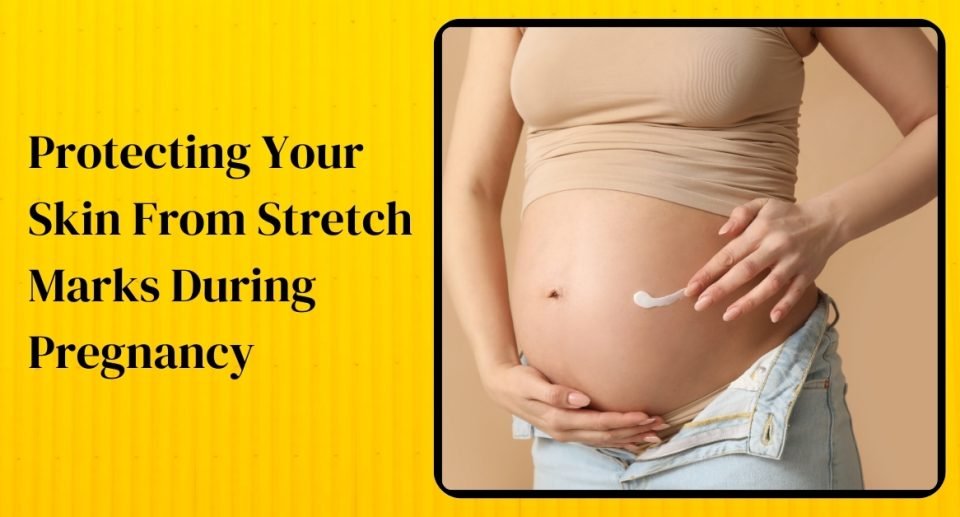Stretch marks, also known as striae, are long, narrow lines that form when the skin stretches rapidly, often during pregnancy, puberty, or significant weight changes. These marks arise when the dermis, the skin’s middle layer, tears due to the stretching of collagen and elastin fibers. Initially, stretch marks appear red, purple, or dark brown, depending on your skin tone, and may fade over time. While not harmful, they can be a cosmetic concern. Preventative strategies and treatments can help reduce their visibility.
Causes of Stretch Marks During Pregnancy
Stretch marks during pregnancy are primarily due to:
1. Hormonal Changes: Pregnancy hormones, particularly cortisol, can increase the likelihood of developing stretch marks by making the skin more fragile and reducing its elasticity.
2. Rapid Skin Stretching: As the baby grows, the skin on the abdomen, breasts, hips, and thighs stretches rapidly, causing tears in the dermis.
3. Weight Gain: The additional weight gained during pregnancy stretches the skin, especially in areas prone to fat accumulation.
4. Genetic Predisposition: Genetics influence skin elasticity. If your close relatives experienced stretch marks during pregnancy, you might be more susceptible as well.
Tips to Prevent Stretch Marks During Pregnancy
1. Maintain a Healthy Diet
Eating a balanced diet supports overall health and skin elasticity. Incorporate foods rich in vitamins A, C, and E, which are vital for skin health. Vitamin A aids skin repair, vitamin C supports collagen production, and vitamin E protects against oxidative damage. Additionally, minerals like zinc and silica strengthen skin. Consume plenty of fruits, vegetables, nuts, seeds, and whole grains for optimal skin health.
2. Stay Hydrated
Hydration is essential for maintaining skin elasticity and preventing dryness, which can worsen stretch marks. Drink at least 8-10 glasses of water daily. Hydrated skin retains moisture better and is more supple, reducing the likelihood of stretch marks. Eating hydrating foods like cucumbers, oranges, and watermelon can also help.
3. Regular Exercise
Moderate exercise enhances circulation and promotes healthy skin. Activities such as walking, swimming, and prenatal yoga are excellent during pregnancy. Exercise helps maintain steady weight gain, preventing rapid skin stretching. Always consult your healthcare provider before starting new exercises.
4. Use Topical Treatments
Daily application of creams, oils, or lotions helps keep skin moisturized and improves elasticity. Look for products containing cocoa butter, shea butter, vitamin E, and hyaluronic acid. These ingredients provide deep hydration, crucial for preventing stretch marks. Apply regularly, especially after bathing.
5. Massage Your Skin
Massaging the skin with moisturizing creams or oils enhances blood circulation and nutrient absorption. Focus on areas prone to stretch marks like the abdomen, breasts, thighs, and hips. Gentle circular motions can improve skin elasticity and blood flow, reducing the risk of stretch marks.
6. Avoid Rapid Weight Gain
Following prenatal care guidelines for gradual weight gain minimizes skin stress. Rapid weight gain stretches skin quickly, increasing stretch mark risk. A balanced diet and regular exercise help maintain steady weight gain.
7. Wear Supportive Clothing
Maternity support belts or bras help support the growing belly and breasts, reducing skin stretching. Supportive clothing provides comfort and distributes health weight evenly, easing skin strain. Choose breathable, comfortable fabrics to avoid irritation.
8. Exfoliate Regularly
Regular gentle exfoliation, once or twice a week, removes dead skin cells and promotes new skin growth. Natural exfoliants like sugar scrubs or oatmeal are gentle on the skin. Exfoliation maintains smooth skin and enhances the effectiveness of moisturizing products.
9. Use Sunscreen
Protecting skin from sun damage is crucial during pregnancy. Sun exposure weakens skin elasticity, making it more prone to stretch marks. Apply sunscreen with at least SPF 30 daily, and wear protective clothing and seek shade to minimize sun exposure.
10. Consider Professional Treatments
For significant concerns about stretch marks, consult a dermatologist. Professional treatments like laser therapy, microdermabrasion, and chemical peels can help prevent and reduce stretch marks. These treatments are most effective when started early and used with other preventive measures. Always discuss treatments with your healthcare provider to ensure safety during pregnancy.
Conclusion
Proactively preventing stretch marks during pregnancy can enhance your skin’s health and appearance. By following the tips in this guide—staying hydrated, moisturizing regularly, and maintaining a healthy lifestyle—you can reduce the likelihood of developing stretch marks. Remember, each person’s body is unique, and some factors like genetics are beyond control. Embrace your pregnancy journey’s beauty, focusing on self-care and acceptance. Additionally, consider using a handheld fetal doppler to monitor your baby’s heartbeat, providing peace of mind and fostering a deeper connection during your pregnancy. These measures support your skin’s health, overall well-being, and create memorable bonding experiences with your baby.





